

|
Wednesday, January 12, 2005 |
VOLUME 5 ISSUE 2 |
By David McFall
An alliance of international auto manufacturers says it has concrete evidence
that API category SA engine oils -- long obsolete but still widely sold -- are
"likely to cause serious damage" and lead to increased emissions if
used in engines built since the 1940s. And now it wants the American Petroleum
Institute, SAE International and other lubricant industry organizations to help
educate consumers not to use such products, which typically lack
engine-protecting additives.
The evidence of the harm caused by using such oil is documented in a recent
report from the Alliance of Automobile Manufacturers, whose member companies
include BMW, Ford, DaimlerChrysler, General Motors, Mazda, Mitsubishi, Porsche,
Toyota and Volkswagen. Using industry-accepted engine sequence tests, the
automakers evaluated an SA oil's effect on engine wear, sludge and deposits --
and found it detrimental in every case.
The Alliance report, "Impact of Low Quality Oils on Engine Wear and Sludge
Deposits; A Comparison of API SA and API SL (ILSAC GF-3) Engine Oils,"
dated Nov. 8, 2004 compared the obsolete API SA oil with an oil meeting API Service
Category SL/ILSAC GF-3, the most current at the time of testing. (The newest
generation oil, SM and GF-4, began entering commercial service after mid-2004.)
The SA oil used in the study was purchased in San Antonio at a national chain
auto-parts store. "This oil is readily available in many areas of the
country," the study pointed out. The SL oil used for comparison was
a "conventional mineral oil certified to meet all API SL engine oil
requirements, including those for low-temperature wear, deposits and
sludge." Tests were conducted in the fourth quarter of 2003 at an
independent testing laboratory. The oils were put through two standard
tests: the ASTM Sequence IVA, a low-temperature valve train wear test and the
Sequence VG test for sludge/deposits.
General Motors' Robert Stockwell, who was involved in the study, pointed out
some of the results to Lube Report, such as filter clogging with the SA oil
(see photos below). "When the pickup tube plugs, oil starvation will occur
on startup and the engine will be destroyed," he explained. "Further,
the extreme scuffing indicated on five camshaft lobes in the SA test indicate
that the life of this engine would be short, regardless of the oil change
interval."
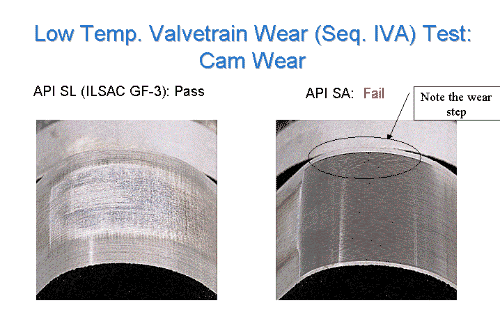
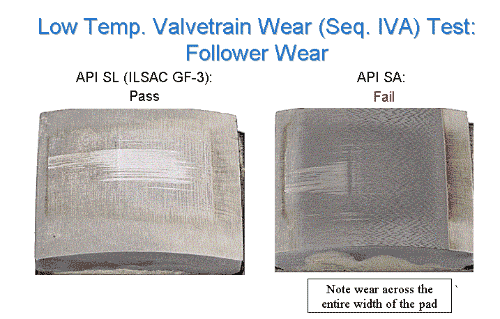
Normally, a Sequence VG engine test runs for 216 hours, but the laboratory's test
engineer stopped the Sequence VG test on the SA oil after only 168 hours,
Stockwell added. At that point, the obsolete oil had clearly failed.
(The test lab was aware of the quality level of the SA oil; the SL oil was
tested blind.) Intermediate inspections of the valve decks, rocker arm covers
and camshaft baffles with the SA oil showed sludge deposits at 144 hours, and
at 168 hours the kinematic viscosity had increased as well.
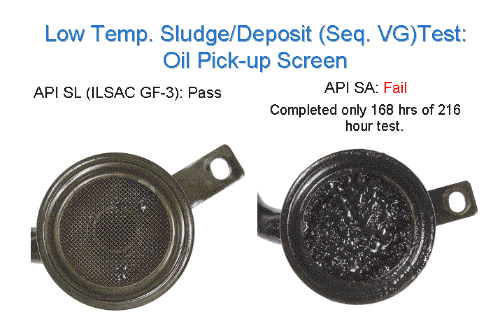
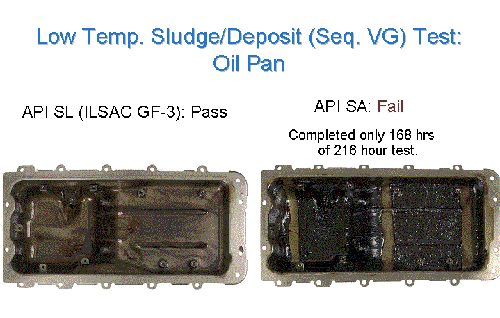
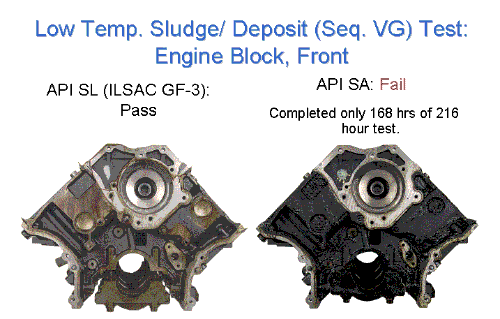
Obsolete oils continue to hold a sizable share of the U.S. engine oil
aftermarket, and are widely sold in discount stores, convenience stores, mass
merchandisers and other retail outlets, particularly in lower-income
neighborhoods and rural areas. Although the marketers of obsolete oils defend
the practice, arguing that the products offer simple, inexpensive lubrication,
the oils do not address wear, sludge, deposits, corrosion and other problems of
concern to automakers since the 1940s. SA oils are the types of oils sold in
the 1930s; the category was defined retroactively and already considered
obsolete when API first set up its engine oil licensing program in the 1960s.
In 2002,
Lubes'n'Greases
magazine
calculated that as much as 20 percent of the passenger car engine oil sold in
the aftermarket in the United States continues to be obsolete and unsupported
by any performance tests, including SA and SB oils that contain no additives at
all. Other obsolete categories include SC through SH for passenger car engines,
and categories CA through CE on the diesel engine side.
With the proof of damage from SA oils on the table, the Alliance wants the
lubricants industry now to take action, beginning with educating consumers.
"The Alliance has asked API, the Independent Lubricant Manufacturers
Association, Automotive Oil Change Association, NADA and other organizations
whose members sell motor oil or interface with the public on lubricant quality
issues, to help publicize this story," Alliance staffer Ellen Shapiro told
Lube Report. "In addition, the Alliance plans to post the study on its web
site and discuss the issue with state regulatory officials."
Actions at the state level could include new prohibitions, enhanced
enforcement, new labeling requirements, and store shelf notices, the Alliance
suggested.
At API, "some Lubricants Committee members had positive reactions to the
presentation," a spokeswoman said. "We will wait for the study to be
posted on the Alliance website to determine what we can do to complement the
Alliance's promotion of its presentation." ILMA went even further,
and posted the Alliance's 12-page presentation on its website last week.
The Alliance has posted the report at its web site. To view it, see
http://autoalliance.org/archives/SA
vs SL comparison 110804 final-rev121604.pdf
.
Lisa Tocci also contributed to this story.
Published by LNG Publishing Co., Inc.
Copyright © 2005 LNG Publishing Co., Inc. All rights reserved.
Tim Sullivan, Editor. Lube Report (ISSN 1547-3392), Lubes'n'Greases
Magazine and Lubricants Industry Sourcebook are published by LNG
Publishing Co., Inc., 6105-G Arlington Blvd., Falls Church, Virginia 22044 USA.
Phone: (703) 536-0800. Fax: (703) 536-0803. Website: http://www.lngpublishing.com/.
Email: info@LNGpublishing.com.
For sponsor information contact Gloria Steinberg Briskin at (800) 474-8654 or
(703) 536-7676 or gloria@LNGpublishing.com.
Note:
While the above article is served from www.synlube.com, the original archived version can be obtained at this link:
Article from LUBE REPORT
Note:
The link to the complete AAM report in PDF format in the "original" above article is no longer functional, an archived copy of that file is served from www.synlube.com, and can be obtained at this link:
API SA comparison.pdf